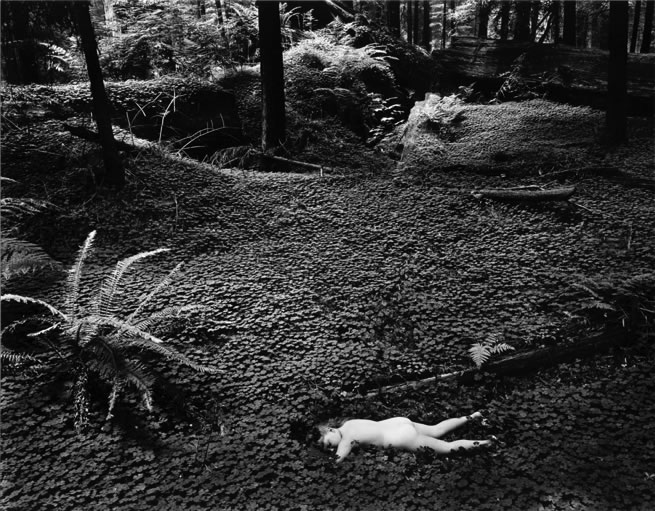Profound meditations on existence define Wynn Bullock's photographs
Posted: 12:00 a.m. Thursday, June 26, 2014

By Felicia Feaster - For the AJC
It's refreshing to see the High Museum's photography curator Brett Abbott taking the unexpected route in his programming.
With his recent retrospective of photographer Abelardo Morell, and now with a photo show devoted to Wynn Bullock - a lesser-known contemporary of Ansel Adams and Edward Weston - Abbott is blessedly less inclined to herald the expected household names. These recent shows demonstrate a consistent, welcome trend for thoughtful, comprehensive tributes to such artists' work rather than no-brainer curtsies to photography's expected big guns.
At face value, California artist Bullock's output, seen in the more than 108 images of mood-saturated landscapes, classical nudes and formal experiments featured in "Wynn Bullock: Revelations," might seem part of a typical high art photographic lexicon. But there is something profound, disquieting - spooky even - in this work that distinguishes Bullock (who died in 1975) as a singular, unusual voice within his chosen field.
There is the feeling in these lovely photographs of death lurking at the margins and of a career-long investigation of the divide between life and death, the world seen and unseen. It's an idea Bullock explored both in his mesmerizing nudes and in his more formal experiments with light and form.
In the exquisite, disturbing black and white photograph "Child in Forest" (1951), which was included in Edward Steichen's groundbreaking 1955 Museum of Modern Art exhibition "The Family of Man," a young girl (Bullock's daughter, Barbara) lies face-down in the midst of a forest, her incandescent white body melding with the sea of leaves beneath her. There is the sense of her flesh merging with the forest, and of the earth reclaiming her in this fascinating image ambiguously hovering between a meditation on nature's consuming pleasures, between a contemplation of creation and of obliteration.
The photo is extraordinary on many levels: for that deep, powerful sense of flesh and forest intermingling, but also for its making. In 1951 the act of photographing one's own 5-year-old child in the nude and exhibiting the subsequent image in public spaces was surely a provocative gesture, but one that continued Bullock's longstanding interest in collisions of the natural world and his human subjects. That lingering interest can also be seen in a series of photos on display in "Revelations," of objects like stones, an apple or gnarled wood, in which human faces and figures can be discerned lurking like trapped souls, from within these inanimate forms. Bullock's daughter Barbara Bullock-Wilson, now grown and working as a writer in California, happened to be strolling through the gallery and confessed that when, as a little girl, she brought "Child in Forest" to her school's show-and-tell, "I discovered that my family was different from other families."
Works such as "Lynne, Point Lobos" (1956), which bears a glancing resemblance to Andrew Wyeth's "Christina's World," evoke something similarly brooding and wounded - a characteristic Bullock blend of beauty and threat held in seductive balance. In the image a little girl stands at the cusp of the ocean, her body framed by rocks on either side. She turns away from us as she watches the water, which is potentially threatening but also thrilling for its power to envelop her small body.
Bodies melding with sand, with forests, a landscape of shadows and fraught with physical extremes address an ongoing idea of the profound, treacherous, contemplative and consuming dimensions to the physical world in this revelatory exhibition. Works such as "Old Typewriter" (1951) illustrate Bullock's ongoing interest in the impermanence of life as seen in the ability of even the most solid and tangible of humankind's innovations to wear away over time.
Experimentation, both literal and philosophical, was both an early and late in life passion for Bullock, from his student work investigating solarization to later color works fascinated with the properties of light: the foundation of photography. "Wynn Bullock: Revelations" is fascinating for what it shows of a questing, ever-engaged photographer's explorative nature and a probing, contemplative mind grappling with the stuff of life and death. As his daughter notes, Bullock "used a camera to ask the really big questions in life."
ART REVIEW
"Wynn Bullock: Revelations"
Through Jan. 18, 2015. 10 a.m.-5 p.m. Tuesdays-Thursdays and Saturdays; until 9 p.m. Fridays; noon- 5 p.m. Sundays. $19.50; $16.50, students and seniors; $12, ages 6-17; free, children 5 and younger and members. High Museum of Art, 1280 Peachtree St. NE, Atlanta. 404-733-4444, www.high.org.
Bottom line: A stunning overview of this exploratory, insightful artist's interest in experimentation and the nature of life and death.
All Content Copyright © 2025 Bullock Family Photography LLC. All rights reserved.